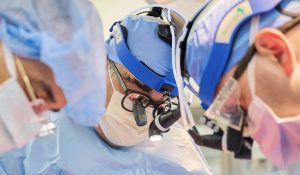
A team at NYU Langone Health successfully transplanted two genetically engineered pig hearts into recently deceased humans in June and July, marking the latest advance toward addressing the nationwide organ shortage and developing a clinical protocol that would provide an alternative supply of organs for people with life-threatening heart disease.
About the Procedures
The surgeries, known as xenotransplants, were performed on Thursday, June 16, 2022, and Wednesday, July 6, 2022, at NYU Langone. Nader Moazami, MD, surgical director of heart transplantation at the NYU Langone Transplant Institute, led the investigational procedures using hearts procured from a facility hundreds of miles away and transplanted into recently deceased donors maintained on ventilator support.
The transplant surgeries were performed over several hours, and heart function was monitored for three days. The first heart xenotransplant concluded on Sunday, June 19, 2022, and the second on Saturday, July 9, 2022. No signs of early rejection were observed in either organ, and the hearts functioned normally with standard post-transplant medications and without additional mechanical support. Using a new infectious diseases protocol, no presence of porcine cytomegalovirus (pCMV) was detected in either case. Strict protocols to prevent and monitor potential zoonotic transmission of porcine endogenous retrovirus (PERV) were also carried out. The operating room used for this study has been taken offline to be used only for future xenotransplantation research.
The hearts were procured from pigs that had 10 genetic modifications, including 4 porcine gene “knockouts” to prevent rejection and abnormal organ growth as well as 6 human transgenes (“knock-ins”) to promote expression of proteins that regulate important biologic pathways that can be disrupted by incompatibilities between pigs and humans. No other investigational devices or medications were used in this NYU Langone study. The procurement, transport, transplant surgery, and immunosuppression were aligned with current clinical standards used in heart transplants.
“Our goal is to integrate the practices used in a typical, everyday heart transplant, only with a nonhuman organ that will function normally without additional aid from untested devices or medicines,” says Dr. Moazami. “We seek to confirm that clinical trials can move ahead using this new supply of organs with the tried-and-true transplant practices we have perfected at the NYU Langone Transplant Institute.”
Alex Reyentovich, MD, medical director of heart transplantation and director of NYU Langone’s advanced heart failure program, says these latest advances in xenotransplantation move the field closer to realizing a new supply of organs for those facing a life-threatening disease.
“This is the first step in developing a deep understanding of the mechanical, molecular, and immunologic aspects of xenoheart transplantation and the feasibility of utilizing standard clinical practice and tools to do so,” says Dr. Reyentovich.
Decedent Model Key to Xenotransplant Research
Robert Montgomery, MD, DPhil, the H. Leon Pachter, MD, Professor and chair of the Department of Surgery at NYU Grossman School of Medicine and director of the Transplant Institute, says xenotransplant studies with recently deceased donors are critical to gathering additional human data needed to advance a field that for decades until last year had been tested only using nonhuman primates.
“Our greater purpose is to address the organ shortage and provide another option for the more than 100,000 people nationwide waiting on that lifesaving gift,” he says. “The paradigm of whole-body donation—when organ donation is not a viable option—is critical to this work moving forward. We are so grateful to the families who volunteer to participate in this research, which will lead to saving untold thousands of more lives.”
Video Credit: Nader Moazami MD interview – NYU Langone Health
The surgeries led by Dr. Moazami were part of a larger study approved by a specially designated research oversight board at NYU Langone and were performed after consulting the New York State Department of Health. They are the latest step in a research protocol that calls for additional and similar procedures to be performed. Whole-body donation after death for the purpose of breakthrough studies represents a new pathway that allows an individual’s altruism to be realized after brain death declaration in circumstances in which their organs or tissues are not suitable for transplant.
“As the organ procurement organization for the greater New York area, we are supportive of NYU Langone’s research efforts,” says Leonard Achan, RN, MA, ANP, president and chief executive officer at LiveOnNY. “Under normal circumstances, one donor can save up to eight lives. But in these special cases, donor heroes have the potential to save countless lives by participating in groundbreaking research. We can never thank these donor heroes and their families enough for saying yes and helping others. It is critically important to continue advancing this research.”
Enhancing the Infectious Diseases Protocol
Dr. Montgomery, who led groundbreaking xenotransplant surgeries using single-gene knockout pig kidneys in September and November of 2021, says one of the critical elements of success in advancing this field is enhanced porcine virus monitoring, which was incorporated in these latest procedures.
“Other studies have shown that pCMV may be a factor in the success of xenotransplanted organs,” he says. “More sensitive screening methods have been introduced to detect low-level traces of pCMV in the donor pigs. We have included that additional screening in this heart transplant protocol to give the organ the best chance at long-term survival.”
The infectious diseases testing protocol developed at NYU Langone was led by Sapna Mehta, MD, director of the transplant infectious diseases program and clinical director of the Transplant Institute.
The hearts used in these procedures were procured from pigs engineered by Revivicor, Inc., a subsidiary of United Therapeutics Corporation, which provided funding for this research.




